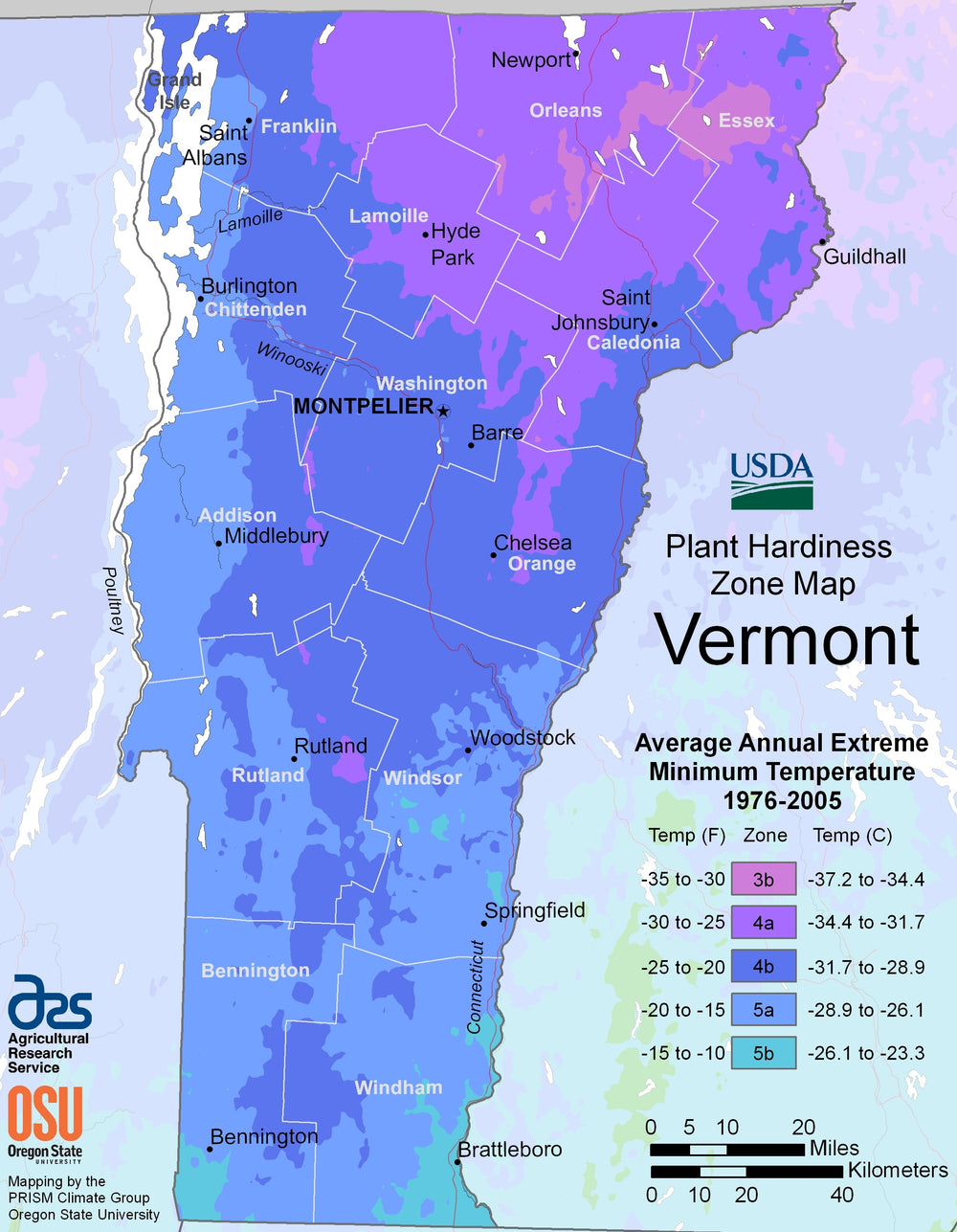Image from USDA
Characteristics of Vermont Planting Region
Vermont has a humid continental climate known for warm, muggy summers and long, brutal winters. The rainfall across the state is significant throughout the year, with some level of precipitation even in the driest months. Some of the more extreme weather that Vermont is prone to includes:
- Severe thunderstorms
- Snowstorms
- Blizzards
- Flooding
- Heavy snowfall
The planting season is relatively short in this region. On average, the frost-free period will begin around mid-May and generally end in the first week of October. However, these timeframes will change dramatically throughout the state, so it’s best to check the frost dates for your specific area.

Winter in Vermont
Challenges of Growing in Vermont
1. Short Growing Season
A limited planting season doesn’t allow many plants to reach maturity in time before the first frost. Therefore, a combination of indoor and outdoor growing may be required in many areas to maximize your growing period.
2. Flooding
Vermont is prone to flooding, making gardening outdoors a risky option. Utilizing raised garden beds and indoor or protected growing may be necessary to keep your plants out of harm’s way.
3. Heavy Snowfall
The abundance of snowfall across the region may prevent you from extending your growing season into the winter months. Indoor or protected growing may be required to ensure your plants will survive.

Stowe, Vermont
The Benefits of Using a Greenhouse in Vermont
There are a variety of advantages of using a greenhouse in the state of Vermont. You’ll be able to extend your growing season well beyond the summer months, keeping your garden safe from the snow and ice throughout winter. Additionally, your garden will be protected from storms and other extreme weather experienced in Vermont. A greenhouse will also allow you to experiment with a range of vegetables and plants that may not have survived with outdoor growing.
1. Extend your Growing Season
-
Without a Greenhouse:
The frost-free growing season in Vermont ranges between 4-5 months. However, the summers are mild, making extended growing seasons difficult without the assistance of indoor growing.
-
With a Greenhouse:
Greenhouse gardeners can effectively double their growing season to 8-10 months annually. This means that those living in this mild climate can maximize their harvest and extend their planting timeframes into the colder months.


Customer images of the Sungrow Greenhouse in a similar climate
2. Grow a Wider Variety of Vegetables
-
Without a Greenhouse:
Without some form of indoor growing, Vermonters are limited to a select few cold-hardy vegetables for outdoor gardening:
- Cress
- Kale
- Lettuce
- Spinach
- Peas
- Radishes
- Beets
-
Chard
-
With a Greenhouse:
Numerous vegetables will thrive in a greenhouse in Vermont. You can dramatically expand your planting options and experiment with more warm-season vegetables. Some of the most recommended crops include:
- Onions
- Carrots
- Fava Beans
- Brussel Sprouts
- Cabbages
- Cauliflower
- Turnips
- Broccoli
- Radishes
- Chives
- Cucumbers
- Eggplants
- Beans
- Tomatoes
- Tomatillos
- Peppers
- Parsley
- Leeks
- Fennel
- Oregano
- Melons
- Soybeans
- Squash
- Pumpkins
- Corn
-
Artichoke

Beets and carrots
Why Planta Greenhouses?
- Wind resistant up to 65 mph (learn more about how our greenhouses hold up in high-altitude climates).
- Withstands a snow load of up to 98 psf (480kg/square meter).
- Made with a heavy-duty galvanized steel frame.
- Polycarbonate panels provide 100% protection against UV rays.
- The Sungrow greenhouse is bell-shaped - allows the wind, snow, and hail to slide off the sides.
- Extendable (Sungrow, Sigma and Farmer models can be extended beyond 100ft)
- Made in Europe and are exclusively imported
- Maintenance-free

